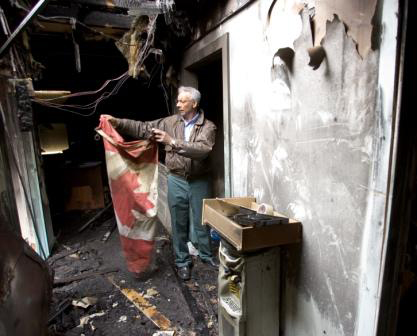
NOVA SCOTIA: MISSISSIPPI OF THE NORTH
From Socialist Canada, "Mississippi of the North: Racist history continues in today’s Nova Scotia," by Denise Allen and Jessica Squires -- On February 24, 2010, two Windsor, Nova Scotia men set fire to a cross and crafted a hangman’s noose around the tree on the property of an African Nova Scotian Shayne Howe near the Black community of Three Mile Plains. The community is also called Windsor Plains and is one of 47 Black communities in Nova Scotia.
This act of terrorism invoked an image most commonly associated with the Ku Klux Klan of the Southern United States, and caused Howe to declare, “Nova Scotia is Canada’s Mississippi of the North!”

Racism is alive and well in Nova Scotia, as it is in the rest of Canada; and Nova Scotia is the starkest portrait of the legacy that colonization and marginalization have wrought for Black people in Canada.
In 2004, UN Special Rapporteur on racism Dou Dou Dienne reported, “Canadian society is not free of racial discrimination.” He went on to note the need for programming to address racism that would “not be limited to the mere equalitarian and democratic superimposition of communities, but which is likely to facilitate interactions, mutual, interpersonal and intercommunity awareness and respect for cultural differences in Canada.”

Racist history
He noted that Canada has not really accepted its racist history, and without recognizing that fact, addressing its effects will remain out of reach.
Canada is rich in Black history and accomplishments, yet most Canadians are not aware that Black people’s ancestry and enslavement predates Confederation (1867).
Black people’s history and contributions to the establishment of Canada have yet to be incorporated into the Canadian public education system, and Black oral history, despite its legitimacy, is dismissed as wishful thinking.
Unbeknownst to most, Nova Scotia was in fact once a slave society. The effects of this oppressive legacy are felt to this day and contemporary human rights violations in Nova Scotia provide clear examples of the pervasiveness of racism in Canadian society. The roots of racism are buried deep in historical patterns of race-based exploitation and marginalization.
But the story of Black people in Canada is far more complex. In contrast to the intentions of white colonizers who came to pillage, rape and enslave, the oral history of indigenous Black Nova Scotians attests to the arrival of African peoples traveling the North Atlantic to share resources and knowledge.
In one documented example, Black explorer Mathieu Da Costa was the interpreter and navigator for Pierre Dugua de Monts and Samuel de Champlain in the early 17th century, suggesting free Africans traveled the Atlantic before the aforementioned white Europeans.
Hundreds of free Blacks from the American colonies supported Britain during the Revolution. Lincolnville, in Nova Scotia, was settled by Black Loyalists in 1784, after the 3,000-acre “Thomas Brownspriggs” land grant pledged to them by Queen Victoria was never honored.
However, these examples have been overwritten by the narrative of black subjugation in a present-day situation with daily reminders of Nova Scotia’s racist roots. Aside from the horrific incident mentioned above, in 2006, a rash of attacks struck fear in the hearts of Nova Scotia’s Black communities.

The Black Loyalist Heritage Centre in Birchtown, Nova Scotia was destroyed by an arson attack. Two weeks later, a Catholic Church hall in Pictou, Nova Scotia was sprayed with the letters KKK. On Easter Sunday, six Molotov cocktails caused an early-morning fire which damaged the roof of the Black Cultural Centre in Dartmouth, near Preston, Nova Scotia.
These attacks, rather than isolated incidents, were tacitly condoned by public policies targeting Black communities and communities of colour across the province.

The society's office was torched in 2006. (CBC)
Nova Scotia harbours toxic environmental racism. In the 1960s, Africville was forcibly relocated to housing projects in Halifax. But before that it was the site of numerous hazardous industries and toxic waste depositories. Today, most of Nova Scotia’s landfills are situated near or in a Black community.
A 1996, Dalhousie University study found that over 30 per cent of African Nova Scotians live within a 5 km radius of a waste dump. This figure has since increased dramatically. Today, the Black residents and community of Lincolnville are threatened by the effects of two landfills located in close proximity to their wells and lakes.
The pattern of environmental racism leaves death in its wake. Numerous indigenous Black Nova Scotian communities have been destroyed. Africville is the most well known example of this merciless form of destruction in Nova Scotia, but there are many other Black and First Nations communities that have suffered a similar fate.

Environmental racism
Environmental racism thrives in areas where residents are denied access to education and employment, and subsequently the necessary resources to mount effective campaigns to defend themselves. On their own, these isolated communities are no match for the relentless business and government interests that benefit at their expense.
Racially segregated schools in Nova Scotia were an accepted practice until 1987. The last legally segregated school was located in Lincolnville. Since 1987, de-facto segregation has remained in many schools through the redrawing of district lines. In this context, the neglect shown towards the academic outcomes of Black learners is appalling. Although the Black Learners Advisory Committee (BLAC) report on Education in Nova Scotia recognizes the link between experiences of racism and underachievement among Black Nova Scotians, only a few of their recommendations have been implemented.

The lack of attention to the impacts of Black history has led the Black communities to their current state: high unemployment, increased violence, police profiling, poverty and, above all, a sense of powerlessness. The recent compensation decision in the case of Africville is at best a symbolic tourist attraction, and a group of former residents and their descendants has launched a new court proceeding in hopes of securing a proper compensation. The struggle continues against racism in Nova Scotia. (source: Socialist Canada)


What is crucial but also missing from the part of the story on the cross-burning on Shayne Howe's property is the fact that he is (or was)in an inter-racial relationship and not only him, but his wife and children were also affected by this event. The story is biased and makes it seem like that he was targeted as an African Nova Scotian, when in fact, the whole family was a target. http://thechronicleherald.ca/novascotiaburning/49401-burning-cross-shaken-family
ReplyDeleteI certainly will not argue with your point about the interracial couple. There are other videos that discuss the interracial aspect of the cross-burning, however many cannot be embedded or are incompatible with file-sharing in the USA.
DeleteThe cross burning incident was not the sole focus of this post, it demonstrated more of the structural nature of the racism in Canada. It seems to me, and of course I'm an outsider looking in, that many Canadians, not all, are in denial about the widespread racism that simmers beneath the surface of public life. I chose this article because it connects various dots of racially motivated violence. The cross burning is just one dot along the spectrum that connects environmental racism, school segregation, bombing/arson of the Loyalist Center, Nazi symbols spray-painted vandalism, automobile arson, etc.
When all of these racial acts of violence are viewed collectively a sinister picture seems to emerge. Sometimes one needs to extend the lense to view the micro with respect to the macro. Denial is not the solution.
Thanks for your thoughtful comments.
--Ron Edwards, US Slave Blog
Fuck em
DeleteFuck all them....may them crosses burn bright!
DeleteAnd fuck you and the NAACP too. Your children and my children shouldnt be at the same schools. Im sick of your scum.
DeleteYour a fucking facebook warrior arent you..then take your inbred children out of the PUBLIC school system and they can be a fucking dunb as you!! What a fucking punk this is! YOUR A LITTLE BITCH..WITH A BIG MOUTH FOR SUCKING YOUR DADDYS DICK!!
DeleteAaron Evans can't afford to go private otherwise he would have done it already. And they are afraid to compete on an even playing field. They enjoy the ball being stacked on their side of the court. They know what black ppl are capable of otherwise they wouldn't go through so much effort to oppress us. Even when we try to do our own things who comes popping up on the scene ...
DeleteHow can I find a copy of Denise Allen and Jessica Squires's book? I can't find a copy held in any library or bookstore, do I have to go to Archives?
ReplyDelete
ReplyDeleteNice article really liked it
plz read also eid al adha wishes 2018
eid al adha wishes for husband 2018
eid al adha wishes for sister 2018
Have a nice day
This comment has been removed by the author.
ReplyDeletenational dog day adoption
ReplyDeletenational dog day contest
national dog day clip art
happy national dog day 2019
national dog day captions
national dog day facts
national dog day cards
This comment has been removed by the author.
ReplyDeleteProfessional completes and talk can correspondingly be perceived on various bits of international news. You can search for after essayists and specialists from around the world at whatever point the masterminding is faultless. News blogs https://mediosindependientes.org/ are the best wellspring of dependable reporting on any space of intrigue. There are express blogs expected to cover present when in doubt news, journalism and breaking news from around the globe. These are all around open on the web.
ReplyDelete